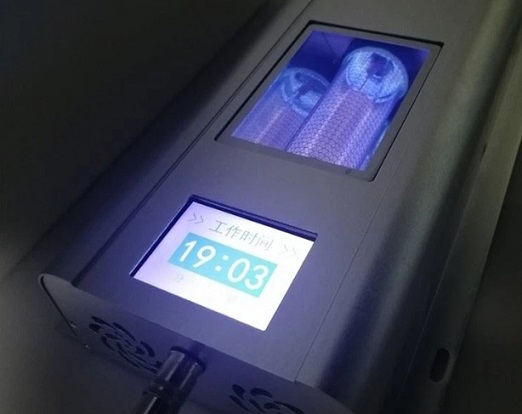Nikhil Prasad Fact checked by:Thailand Medical News Team May 28, 2025 5 months, 1 week, 5 days, 22 hours, 49 minutes ago
Medical News: Concerns Arise Over the Safety of Far-UVC Radiation in Real-World Use
For years, Far UVC light, specifically at 222 nanometers (nm), has been promoted as a safer alternative for disinfection in public spaces, touted for its ability to kill viruses and bacteria without harming human skin or eyes. It has even been proposed for use in operating rooms and crowded indoor environments. But a groundbreaking new Brazilian study is challenging this assumption and revealing that even so-called “safe” doses of Far UVC light can pose health risks over time.
 Brazilian Study Exposes Dangers of Far UVC 222nm Radiation Once Touted as Safe!
Brazilian Study Exposes Dangers of Far UVC 222nm Radiation Once Touted as Safe!
The research, conducted by scientists from the Brazilian Synchrotron Light Laboratory (LNLS) at the Brazilian Center for Research in Energy and Materials (CNPEM) and the University of São Paulo, examined the biological effects of both Far UVC (222 nm) and traditional Near UVC (254 nm) irradiation on human skin models and live animal subjects. This
Medical News report delves into their alarming findings, raising important safety concerns that could affect public health policies around UVC sterilization.
Even at “Safe” Levels, Far UVC Triggers Oxidative Stress
The study revealed that Far UVC (222 nm) promotes the generation of reactive oxygen species (ROS)—unstable molecules that can cause cellular damage—even at doses previously considered safe for occupational exposure (25 mJ/cm²). These findings are significant because ROS are known to damage cell structures, including proteins, lipids, and DNA, potentially leading to aging, inflammation, and disease development.
Although Near UVC (254 nm) generated higher levels of ROS at high doses (1500 mJ/cm²), Far UVC was still capable of initiating harmful oxidative stress responses at much lower doses. This raises red flags about repeated or prolonged exposure in environments such as hospitals, offices, and schools where these devices are increasingly installed.
Far UVC Alters Skin Regeneration and Protein Structures
One of the most concerning revelations was Far UVC’s impact on the skin's natural healing abilities. The researchers found that exposure to 222 nm light at the occupational limit dose disrupted pathways involved in skin regeneration, reducing the tissue’s ability to repair itself over 48 hours. These subtle changes may not be immediately visible but could have serious implications for people frequently exposed to this type of light.
The study also examined proteome alterations—changes in the structure and function of proteins within cells. Because Far UVC is more intensely absorbed by proteins than DNA, it can cause photooxidation and cross-linking of amino acid chains. This disrupts the function of essential cellular machinery and potentially alters immune responses and tissue integrity.
Long-Term Mouse Study Reveals Skin Damage
To understand
the cumulative effects of Far UVC exposure, the researchers conducted a 40-day in vivo study using hairless HRS/J mice. The animals were exposed daily to Far UVC at the threshold limit value (TLV) of 25 mJ/cm² for eight hours a day. While the radiation caused less immediate DNA damage compared to 254 nm UVC, changes in skin structure and increased activity of matrix metalloproteinase-9 (MMP-9)—an enzyme associated with skin aging and degradation—were detected.
These findings suggest that even if Far UVC does not cause immediate visible harm, chronic exposure can still lead to subtle but potentially dangerous biological changes.
Key Dangers of Far UVC (222 nm) Identified in the Study
-Generation of ROS at safe exposure levels, contributing to oxidative stress and cellular damage
-Disruption of skin regeneration pathways, impairing natural healing processes
-Protein oxidation and cross-linking, which can compromise cell function
Increased MMP activity, indicating skin degradation over time
-Potential for long-term cumulative effects, even without visible erythema or DNA dimer formation
Current Guidelines May Underestimate Long-Term Risks
Present safety standards, including those from the American Conference of Governmental Industrial Hygienists (ACGIH) and the International Commission on Non-Ionizing Radiation Protection (ICNIRP), allow for daily exposure to Far UVC at 25 mJ/cm². But this new study calls those thresholds into question. The biological effects seen—even at these regulated limits—suggest that long-term human exposure could have unforeseen consequences, especially in occupational or public settings where exposure is consistent and prolonged.
Conclusion
This Brazilian study is the first of its kind to assess not only the DNA-damaging potential of Far UVC light but also its impact on proteins, skin regeneration, and oxidative stress pathways. The researchers conclude that while Far UVC is less damaging than Near UVC in the short term, chronic exposure—even at doses considered safe—can alter fundamental cellular functions and compromise skin health. These findings warrant a re-evaluation of current safety guidelines and more stringent oversight of Far UVC applications, especially in environments with vulnerable populations such as hospitals and schools.
The study findings were published in the peer reviewed journal: Journal of Photochemistry and Photobiology B: Biology
https://www.sciencedirect.com/science/article/abs/pii/S1011134423000672
For the latest news, keep on logging to Thailand
Medical News.
Read Also:
https://www.thailandmedical.news/news/warnings-raised-by-leading-german-radiation-experts-over-the-use-of-far-uvc-for-disinfection-around-humans
https://www.thailandmedical.news/news/breaking-alarming-study-reveals-that-far-uvc-light-might-not-be-as-safe-as-previously-believed-can-cause-dna-damage
https://www.thailandmedical.news/articles/covid-19-disinfectants
https://www.thailandmedical.news/pages/thailand_doctors_listings
https://www.thailandmedical.news/news/study-shows-that-disinfectants-containing-benzalkonium-chloride-can-give-rise-to-drug-resistant-microbes
